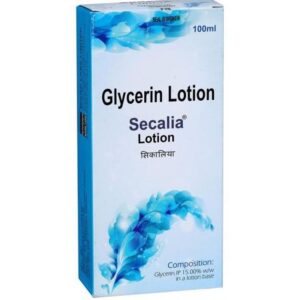GLYCERINE + WHITE PETROLATUM
Glycerine: Glycerin, also known as glycerol, is a colorless, odorless, sweet-tasting substance that is commonly used in pharmaceuticals, cosmetics, and food additives. It has various therapeutic applications and is used both internally and externally.
One of the primary uses of glycerin is as a laxative. It works by attracting and retaining water in the intestine, softening the stool and promoting bowel movements. It is usually taken orally in liquid form and is effective for relieving occasional constipation. The dose for laxative purposes is typically 15-60 ml (1-4 tablespoons) of glycerin liquid.
Glycerin also finds use topically, as it has emollient and hydrating properties. It is often included in moisturizers, creams, and lotions to help soothe and moisturize dry and irritated skin. Additionally, it may be applied to the rectal area to relieve anal and rectal irritation, such as hemorrhoids.
The mechanism of action of glycerin as a moisturizer is based on its ability to attract and retain water in the skin, thereby increasing hydration and reducing dryness. When used topically, it forms a protective barrier on the skin, sealing in moisture and preventing excessive water loss.
As for side effects, glycerin is generally considered safe when used as directed. However, some potential side effects may include gastrointestinal discomfort, nausea, bloating, or diarrhea when taken orally as a laxative. When used topically, it is usually well-tolerated, but in rare cases, it may cause skin irritation or allergic reactions.
It is important to consult a healthcare professional or follow the instructions provided with the specific glycerin product for the appropriate dosage and usage recommendations.
White Petrolatum: White Petrolatum, also known as petroleum jelly, is a widely used topical drug. It is a semi-solid mixture of hydrocarbons derived from petroleum. It is commonly used as a moisturizer and skin protectant.
The main use of white petrolatum is to prevent dryness and soothe minor skin irritations. It can help to lock in moisture and create a protective barrier on the skin, which aids in reducing water loss and supporting the skin’s natural healing process. Due to its occlusive nature, it can also be used to prevent chapping, especially in cold weather.
The mechanism of action of white petrolatum is simple – it forms a layer on the skin’s surface, which minimizes water loss through evaporation and provides a barrier against external irritants. It does not have any active ingredients that have a direct effect on the body. Instead, it acts as a physical barrier and prevents moisture loss from the skin.
White petrolatum is typically applied topically. The appropriate dose varies depending on the individual and the specific condition being treated. It is generally recommended to apply a thin layer to the affected area as needed or as directed by a healthcare professional.
White petrolatum is considered safe for most individuals when used as directed. It is well-tolerated and rarely causes side effects. However, some individuals may experience skin irritation or allergic reactions, such as rash, itching, or redness. If any severe or persistent side effects occur, it is important to seek medical attention.
As white petrolatum is not absorbed into the bloodstream, there are minimal systemic side effects associated with its use. However, if ingested, it can cause gastrointestinal discomfort and, in rare cases, aspiration pneumonia. It is important to keep white petrolatum out of reach of children to avoid accidental ingestion.
Overall, white petrolatum is a versatile and widely used topical drug that provides moisturizing and protective effects for the skin. It is commonly used as a preventive measure against dryness and minor skin irritations. However, it is always advisable to consult a healthcare professional or pharmacist before using any medication or drug.

